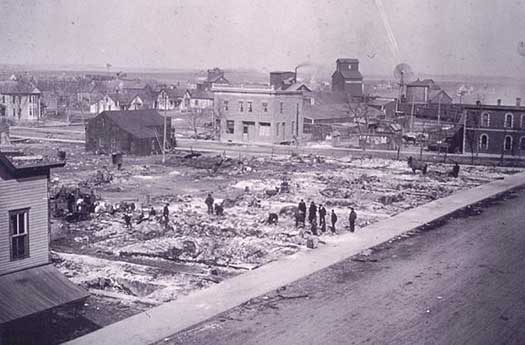Minnesota is fortunate in that its inland location removes us from the threat of hurricanes or tidal waves. We are also fortunate to be located in the lowest risk seismic category which virtually eliminates the threat of earthquakes. The FEMA map that is included in the plan indicates the most recent natural disasters that have occurred in Minnesota. The following sections discuss the types of natural disasters that are a threat in Minnesota.
Both tornadoes and straight line winds can cause major damage to historic buildings. Tornadoes generally have fairly narrow paths and can move erratically. The 1998 St. Peter tornado was an exception to this pattern; there the path was approximately a mile wide.
Straight line winds often impact a wider area than tornadoes, as illustrated by the July 4, 1999 storm along the Gunflint Trail which affected portions of three counties. Since Minnesota is not a coastal state, wind storms are usually of fairly short duration, very intense and hard to predict.
The primary effect on buildings is structural damage due to the lifting or suction force of the wind from the exterior, as well as the blow-out force of the wind if it penetrates the interior. The results can be loss of roofs, walls, porches, lifting the building off the foundation, or complete destruction. Other sources of wind damage are from trees and wind-born objects and debris. Rain during or after a wind storm is also a threat. If the damaged building is left unprotected, water infiltration can cause additional damage.

Flooding from spring snow melt and rain is a major cause of damage in the river valleys. Snow and rain amounts are closely monitored, and the potential effect on rivers can be projected days or weeks in advance, which provides time for property owners and communities to prepare for floods. The areas most likely to be flooded are defined on Corps of Engineers maps by 100 year or 500 year flood plain elevations. The areas at or below these elevations are the most likely to be affected by flood. Past flood records also show the areas most likely to be affected by flooding.
Flash flooding from intense rain storms can occur quickly without much advance warning. Flash flooding can occur in much smaller areas, and often affects small streams and storm drainage systems. The flooding generally only lasts as long as the heavy rain continues to overtax storm drainage systems.
The primary damage to historic buildings in a flood disaster is from immersion of building materials in flood waters. The force of the moving water can cause structural collapse of structures. In addition, storm and sanitary sewer back-up during flooding is a major cause of damage to buildings. Fire due to ruptured utility lines, growth of mold and mildew, and swelling, warping, and disintegration of materials due to prolonged presence of moisture are also threats in a flood disaster.

Wildfires or forest fires affect buildings on prairies or in forests, and could encompass large land areas. This type of disaster is generally the result of dry, windy conditions which are monitored by the National Forest Service and the Minnesota Department of Natural Resources Division of Forestry, who usually can provide adequate warning. The threat of fire can last for an extended period of time although the serious exposure to an individual property could be much shorter.
Lightning related fire would usually be limited to a single building per strike. The threat of lightning is present during severe storms which can also produce high winds and tornadoes. The threat of lightning during a storm is hard to predict.
Arson and building fault fires are not natural disasters, but the results are the same. Building fault fires are generally preventable with routine inspection and maintenance programs.
The primary damage is caused by consumption of combustibles by fire and collapse of portions or all of the building. Smoke produced by the fire can penetrate and damage portions of the building unaffected by actual burning. Water damage during fire fighting to burned and undamaged portions of the building is also a threat; during freezing weather, this can also result in ice damage to the structure. If the damaged building is left unprotected, moisture infiltration from snow and rain can produce additional damage.
Heavy accumulation of snow and ice during winter storms can cause damage to historic buildings. Minnesotans are accustomed to snow, and weather forecasts can generally provide adequate warnings of heavy snow or ice storms. Proper building insulation, vapor barriers, and building maintenance can greatly reduce the build-up of ice that could cause building damage.
Roof and building collapse can result from snow build-up that exceeds the load capacity of the roof. Collapse due to overloading can usually be prevented by removing excess snow as it accumulates. If damaged buildings are left unprotected, later storms can cause additional damage. Prolonged ice and snow buildup on roofs can cause ice dams which will allow moisture to penetrate the building and damage both interior materials and structural members. Fallen trees and limbs can cause further damage to historic buildings. In addition, the loss of electricity for extended time periods can result in additional damage from frozen pipes and stress on building finishes due to temperature extremes.